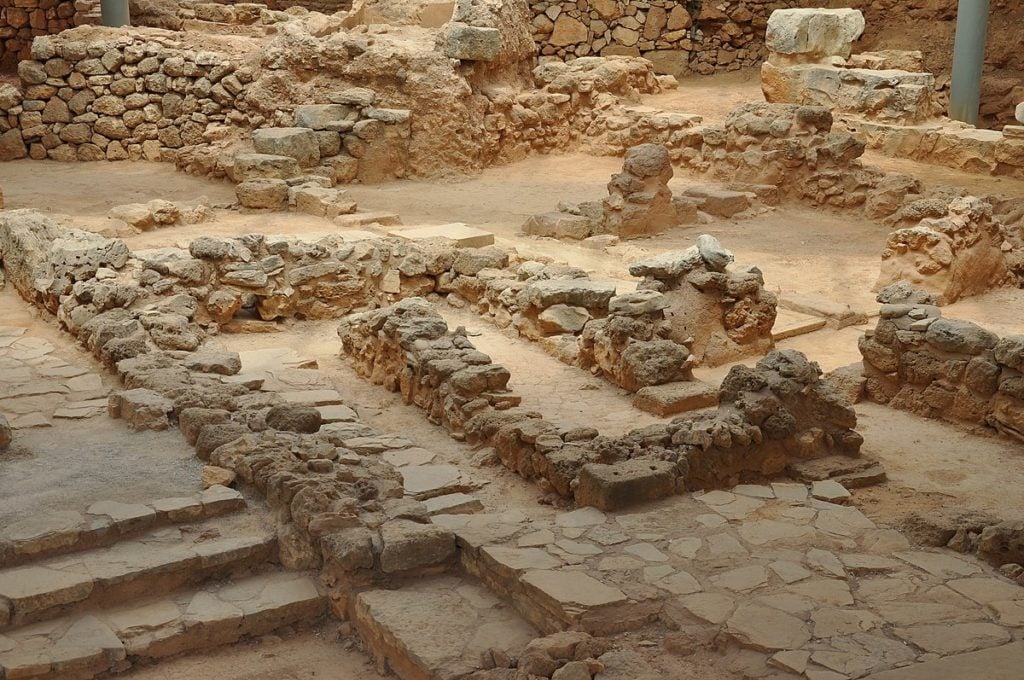
The elite society in Minoan Crete (3500 BC–1100 BC) evidently believed in complex death rituals and sacrificial ceremonies, particularly when it came to their own burials. That is what experts believe after discovering a sacrificial bull’s head in a Minoan cemetery associated with the palace of Petras. The artefact is of significant importance as it provides a better overview of the equally complex jigsaw of funerary rituals followed in antiquity.
Archaeologist Metaxia Tsipopoulou, who specializes in Minoan civilization, said of finding of evidence of the bull’s sacrifice that it, “may possibly be the oldest ritual (found) in a Minoan tomb that relates to this animal of outstanding importance,” according a report by ANA-MPA.
Tsipopoulou has been excavating at the site of Petras since the 1980s. Consequently, it has formed the cornerstone of her work.
Ancient death rituals in Minoan Crete
The upper classes apparently used the excavated cemetery, which had never been plundered, from 2800 BC to around 1750 BC.
There, Tsipopoulou and her team unearthed bone depositories in 26 different funerary buildings that the elites from that society had used for more than primary burials. Each building contained around 14 rooms. The bull’s head was discovered in Funerary building 9 (1920 BC- 1750 BC), and Area 8 in particular.
“There were no other bones of the animal besides the cranium. Obviously the sacrifice took place at another cemetery section,” she mentioned.
Like modern societies, the Minoan elite apparently also believed in keeping death separate from the daily life they were living. Thus, anything used in and for the burials ” would remain in the area (of the ritual), because, as in other societies, whatever was connected to death never returned to the residence complex to be used, but they used to break it and leave it in the cemetery areas.”
For that reason, the artefacts were strewn, albeit meticulously, all over Area 8. The open sky above it provided light. However, they also used lamps to make the space brighter. There, Tsipopoulou identified the six vessels that included two triton shells, the lamp, a censor, a cup, three wide-spout pitchers known as prochooi and the cranium of the bull.
The archaeologist stated the triton shells in particular were significant as they “were very important in Minoan religion… (they) are something sacred, as are bulls.” Only the cranium was located there however, indicating that the sacrifice itself had taken place somewhere else.
The design and date of the pottery reflects the sacrificial placement to approximately 1850 BC. “We don’t know what prompted this elite family to sacrifice an extremely valuable animal,” Tsipopoulou said according to a report by ANA-MPA, “but perhaps it followed a strong earthquake or a pandemic or a dangerous and fatal natural phenomenon like a tsunami.”
Removing it took almost two full months, and later the team then sent it to a laboratory at Oxford University for closer analysis.
Elites dined on sacrificial bull
Researchers at Oxford University also found indications that the deposit took place after the animal was eaten. Its tongue, which was considered a treat, had been removed, and as a result, its lower jaw had broken.
Such a task would have been relatively easy as well, as they suspect the bull was only 5 years old and domesticated. No evidence of human burial was found in Area 8.
At the Petras Minoan cemetery, almost all burials are secondary, meaning that the body remained in one area until the flesh dissolved and the bones were moved, along with valuable objects. These include cylinder seals, stone pottery pottery, gold or silver beads sewn onto garments – to the funerary buildings – art also being a major part of their funerary rituals throughout Ancient Greece.
“Petra never ceases to amaze us,” Tsipopoulou stated.
See all the latest news from Greece and the world at Greekreporter.com. Contact our newsroom to report an update or send your story, photos and videos. Follow GR on Google News and subscribe here to our daily email!



